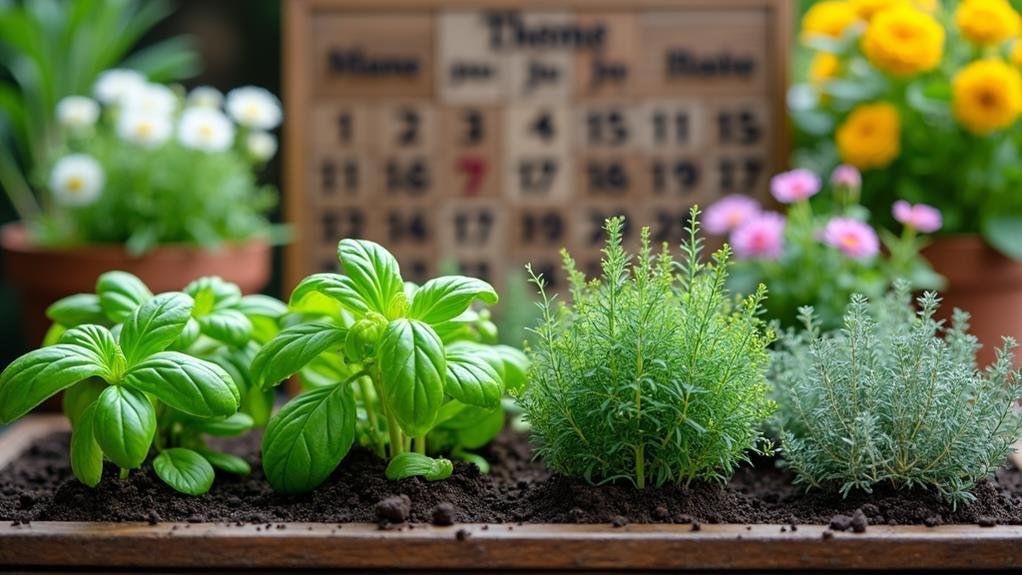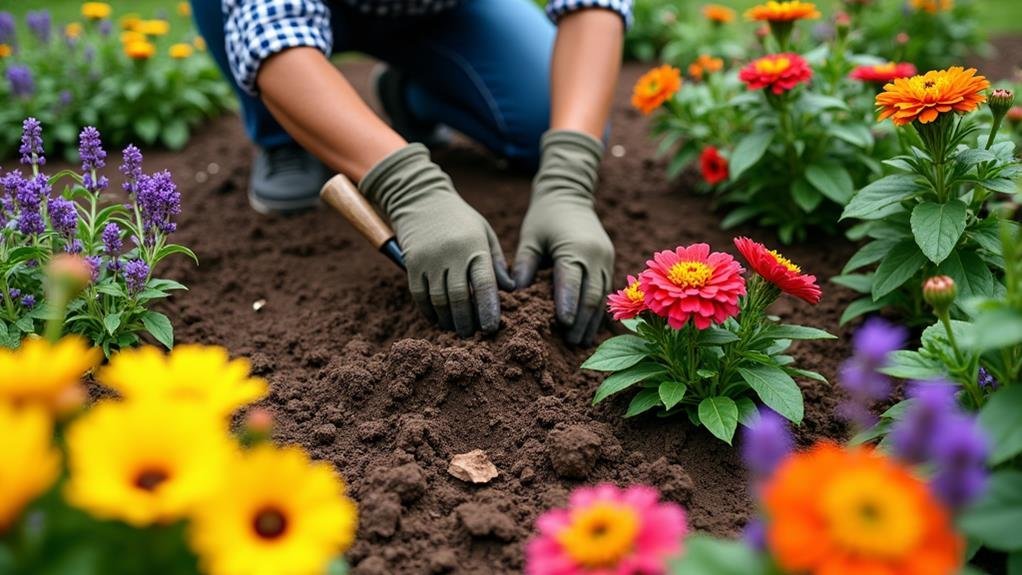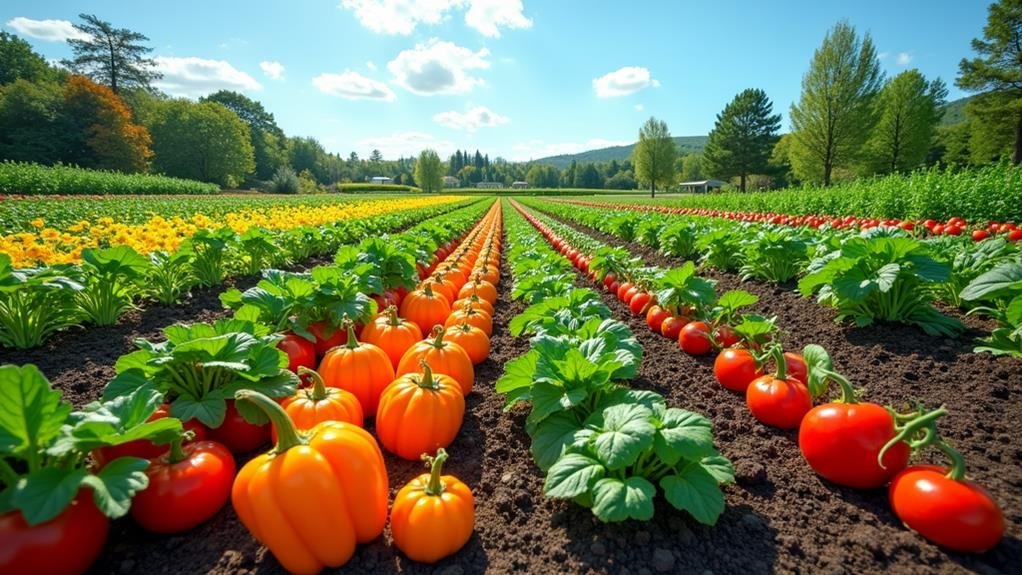When you're planning your herb garden, it's essential to understand the right time to plant each herb for peak growth and flavor. In spring, for instance, you might find that basil and parsley thrive in warm, sunny spots, while summer calls for robust varieties like rosemary. However, as the seasons change, your planting strategy must adapt too. What herbs should you focus on in the fall, and how can winter indoor gardening improve your culinary experience? Let's investigate these seasonal nuances together.
Spring Herb Planting Guide
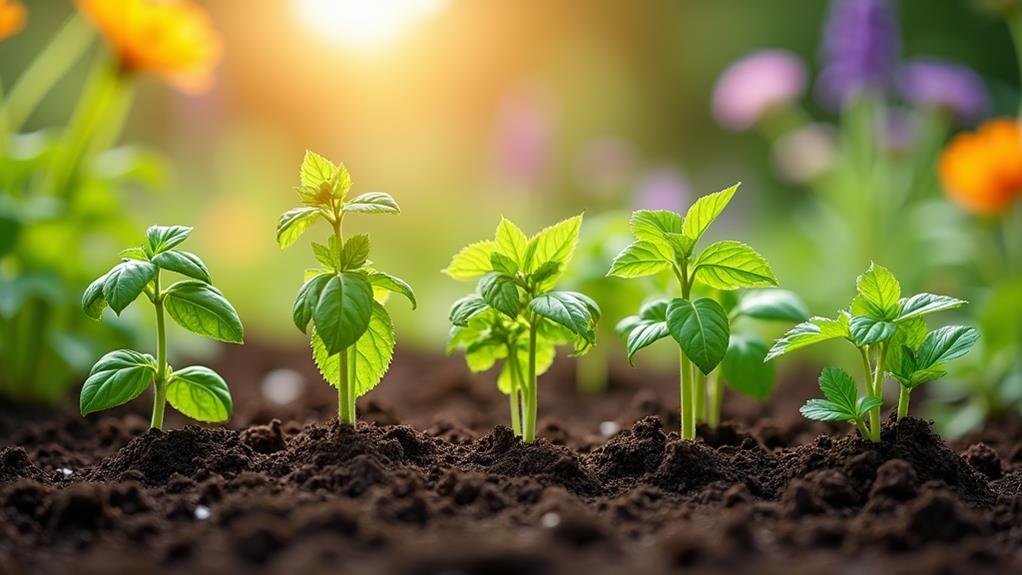
As the days grow warmer in spring, it's the perfect time to start planting your herbs. You'll want to choose a sunny spot in your garden or on your balcony, as most herbs thrive in full sunlight.
Start by preparing the soil; it should be well-draining and rich in organic matter. Consider mixing in compost to give your herbs the best chance to flourish.
When selecting herbs, think about what you enjoy cooking with. Basil, parsley, and chives are great choices for beginners. You can either sow seeds directly into the ground or start with young plants from your local nursery. If you're starting from seeds, follow the packet instructions for planting depth and spacing.
Water your newly planted herbs thoroughly but avoid overwatering. It's essential to keep the soil moist while they establish roots.
As they start to grow, you can gently pinch back the tips to encourage bushier growth. And remember, herbs are forgiving; if something doesn't go as planned, you can always try again.
Enjoy the process, and soon you'll have fresh herbs ready to enhance your meals!
Summer Herb Planting Tips
During the warm days of summer, it's essential to keep your herbs well-cared for to guarantee a bountiful harvest. Start by ensuring your herbs get plenty of sunlight. Most herbs thrive in at least six hours of direct sunlight daily, so place them in a bright spot.
If you're growing them indoors, consider rotating pots to give all sides equal exposure.
Water your herbs consistently but avoid overwatering. The top inch of the soil should dry out between watering sessions, which helps prevent root rot. If you're unsure, stick your finger in the soil; if it feels dry, it's time to water.
Fertilizing is also vital during summer. Use a balanced, water-soluble fertilizer every four to six weeks to promote growth.
And don't forget to prune! Regularly snip away dead leaves and stems, which encourages bushier growth and improves flavor.
Fall Herb Planting Strategies
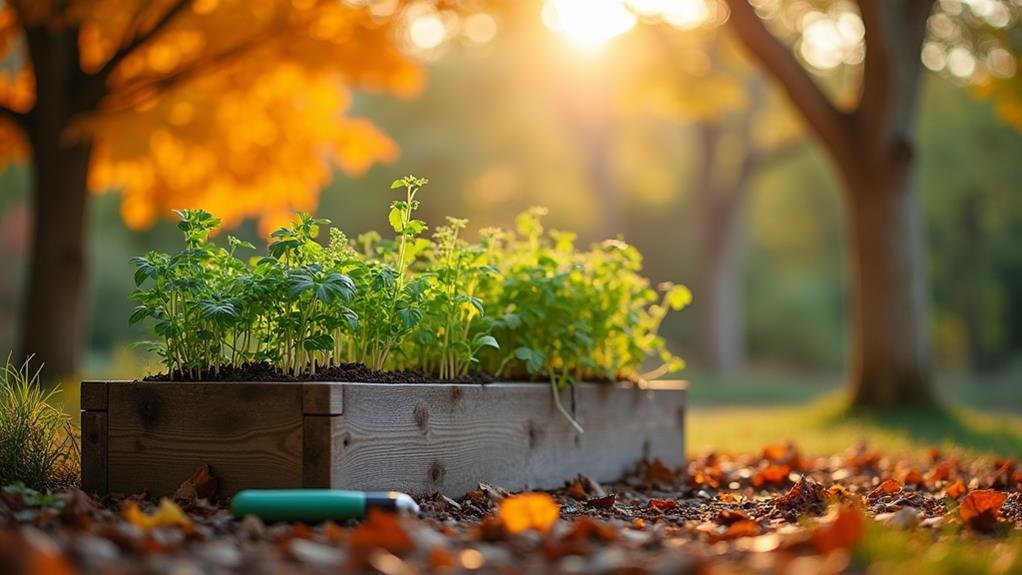
Fall's cooler temperatures create a perfect environment for planting herbs that thrive in slightly brisk conditions. As you prepare your garden, consider opting for hardy herbs like parsley, cilantro, and chives. These varieties not only tolerate cooler weather but often taste better after a frost.
Before planting, choose a sunny spot in your garden or containers that receive at least six hours of sunlight daily. Verify your soil is well-drained, as soggy roots can lead to rot. You might want to amend the soil with compost to boost nutrients, giving your herbs a healthy start.
When planting, space your herbs about 12 to 18 inches apart to allow for growth and airflow. Water them well after planting, but avoid overwatering, which can be tempting in the cooler months.
Keep an eye on the weather—if frost is predicted, you can cover your herbs with a cloth or bring container plants indoors for protection.
Lastly, don't forget to harvest regularly. Snipping leaves not only encourages growth but also allows you to enjoy fresh herbs in your favorite fall recipes. Happy planting!
Winter Herb Planting Techniques
Winter offers a unique opportunity to cultivate herbs, especially if you take advantage of indoor gardening techniques.
First, choose a sunny spot in your home, ideally near a south-facing window, where herbs can soak up as much light as possible. If natural light is limited, consider using grow lights to supplement their needs.
Next, select pots with good drainage to prevent waterlogging. Fill them with quality potting soil, rich in nutrients. You can start with seeds or purchase seedlings from a nursery. If you opt for seeds, plant them according to the package instructions, ensuring they're not buried too deep.
Water your herbs carefully, allowing the soil to dry slightly between waterings, as overwatering can lead to root rot. Keep an eye on humidity levels; herbs generally prefer a humid environment. You might want to mist them occasionally or use a humidity tray.
Lastly, don't forget to prune your herbs regularly. This encourages bushier growth and prevents your plants from becoming leggy.
With these techniques, you can enjoy fresh herbs all winter long, adding flavor to your meals and a touch of greenery to your home.
Best Herbs for Each Season
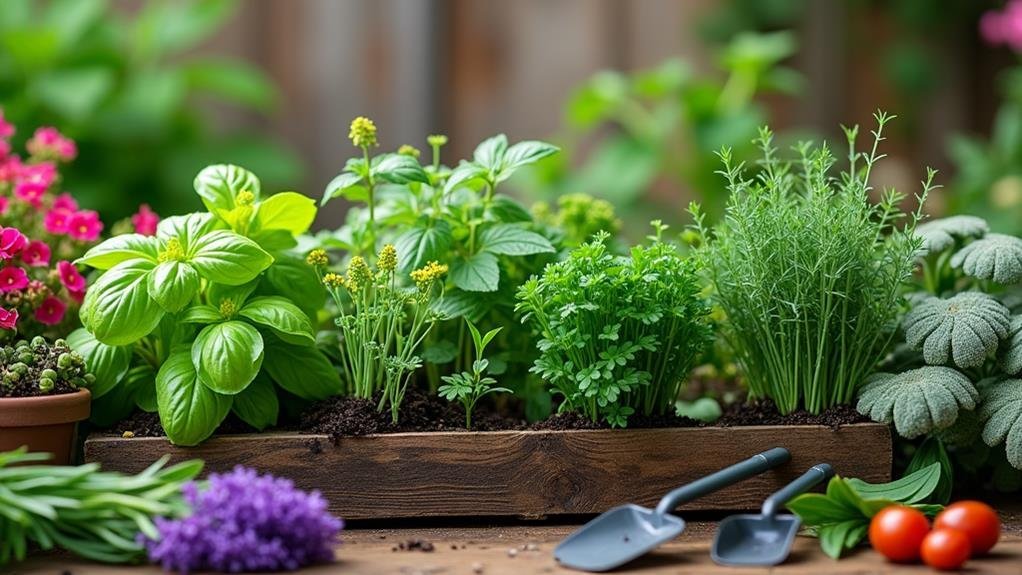
Choosing the right herbs for each season can improve your gardening experience and guarantee a thriving harvest year-round.
In spring, consider planting basil, cilantro, and parsley. These herbs thrive in the warmer temperatures and will add fresh flavors to your dishes.
As summer rolls in, you'll want to focus on herbs like rosemary, thyme, and oregano. These heat-loving varieties can handle the sun and make excellent companions for your barbecued meals.
When fall approaches, it's time to plant dill and chives. These herbs can withstand cooler temperatures and will continue to grow until the first frost hits. Their flavors are perfect for autumn recipes.
Finally, during winter, you might think gardening is over, but it's not! You can start growing indoor herbs like mint and sage.
They're perfect for adding a burst of flavor to your holiday meals and drinks.
Indoor Vs Outdoor Planting
Often, gardeners face the decision of whether to plant herbs indoors or outdoors, and each option has its unique advantages.
Indoor planting gives you greater control over the environment. You can regulate temperature, humidity, and light, ensuring your herbs thrive year-round. Plus, it's convenient for those with limited outdoor space or colder climates. You can easily snip fresh herbs while cooking without stepping outside.
On the other hand, outdoor planting allows your herbs to benefit from natural sunlight and fresh air. Most herbs prefer full sun, and growing them outside can improve their flavor and aroma. Outdoor gardens can also attract beneficial insects, which can aid in pollination and pest control.
However, consider the potential challenges of outdoor planting, like pests or unpredictable weather. Each choice has its pros and cons, so think about your space, climate, and lifestyle.
If you've got a sunny windowsill, indoor herbs can flourish beautifully. But if you enjoy spending time in your garden, outdoor planting might just be your best bet.
Ultimately, the choice is yours, and you can always experiment to find what works best for you!
Companion Planting for Herbs
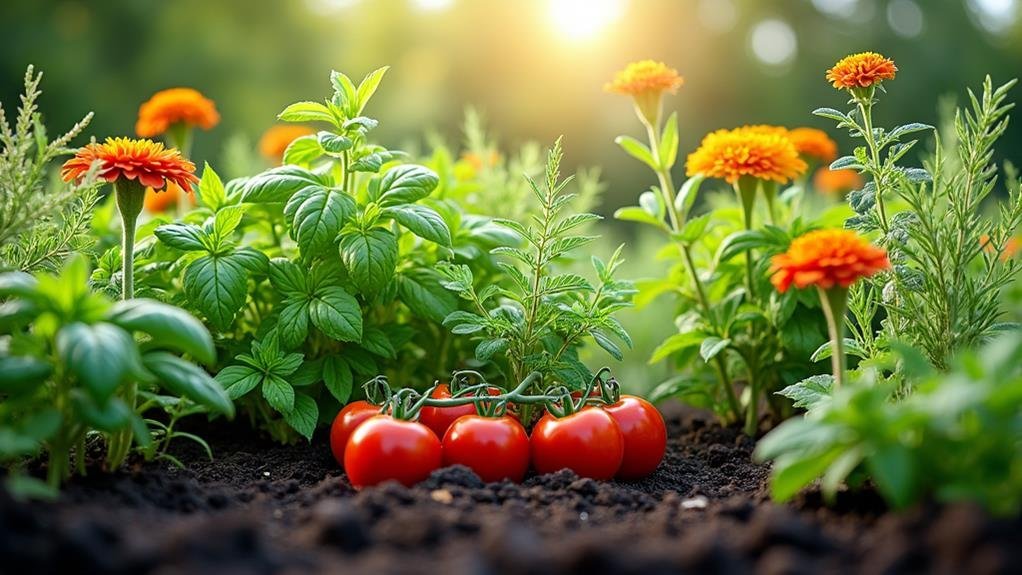
When planting herbs, companion planting can improve their growth and flavor while also discouraging pests. Pairing herbs with the right companions can create a more thriving garden.
For example, basil grows exceptionally well alongside tomatoes. The two not only enjoy similar growing conditions but also elevate each other's flavors, making your dishes even more delicious.
Another great combination is rosemary and cabbage. Rosemary repels certain pests that can harm cabbage, allowing your vegetables to flourish.
On the other hand, mint is known to deter pests, but it can be invasive, so it's best to plant it in a pot to keep it contained while benefiting nearby herbs.
Consider planting chives near carrots; chives can ward off the pesky carrot fly, protecting your harvest.
Additionally, dill attracts beneficial insects, such as ladybugs, which help control aphid populations.
Soil Preparation Essentials
Healthy soil is the foundation of a thriving herb garden. To prepare your soil, start by testing its pH level. Most herbs prefer a slightly acidic to neutral pH, around 6.0 to 7.0. You can buy a simple kit at your local garden center or send a sample to a lab for a more detailed analysis. Once you know your soil's pH, you can amend it as needed.
Next, clear the area of weeds, rocks, and any debris. This guarantees your herbs won't compete for nutrients.
Loosen the soil to a depth of about 12 inches using a shovel or garden fork. This aeration helps roots grow freely and access essential nutrients.
Incorporate organic matter like compost or well-rotted manure into the soil. This not only enriches the soil but also improves drainage, making it easier for your herbs to thrive.
Aim for a mix of about one part organic matter to three parts soil.
Watering and Maintenance Practices

To guarantee your herbs thrive, consistent watering and proper maintenance are essential. Start by checking the moisture level in the soil. It should be damp but not soggy. Water your herbs deeply, allowing the roots to soak up moisture. Typically, herbs need watering once a week, but this can vary based on your climate and whether they're indoors or outdoors.
Always water in the morning to reduce evaporation and prevent fungal issues.
Next, keep an eye on the leaves. If they start to yellow, it might be a sign you're overwatering. Conversely, if the leaves are wilting, they may need more water.
Regular maintenance doesn't stop at watering. Prune your herbs regularly to encourage growth and prevent overcrowding. You'll also want to remove any dead or yellowing leaves, as they can attract pests.
Lastly, consider fertilizing your herbs every few weeks during the growing season. Use a balanced, water-soluble fertilizer for the best results.
With these practices, you'll have healthy, vibrant herbs ready for your culinary adventures! Remember, a little attention goes a long way in herb gardening.
Common Herb Planting Mistakes
Many gardeners unknowingly make mistakes that can hinder their herb planting success. One common error is overwatering. While you might think giving your herbs a good soak is beneficial, too much water can lead to root rot. Always check the soil moisture before watering.
Another mistake is planting herbs that aren't suited to your climate. Not all herbs thrive in every region, so it's important to choose varieties that match your local conditions. Researching your zone can save you a lot of frustration.
Also, don't forget about spacing. Many gardeners cram herbs too close together, thinking they'll maximize yield. However, inadequate space can stunt growth and promote disease. Give each plant room to breathe!
Lastly, consider sunlight. Some herbs need full sun, while others prefer partial shade. Placing them in the wrong light can hinder their growth and flavor.
Avoiding these common pitfalls can lead to a thriving herb garden. Remember, gardening is a learning process, so don't be too hard on yourself. Just keep these mistakes in mind, and you'll be well on your way to herb-planting success!
Conclusion
By following this herb planting timetable, you can enjoy a flourishing garden year-round. Each season offers unique opportunities to grow delicious herbs that improve your meals and brighten your space. Remember to prepare your soil, water regularly, and consider companion planting to boost your herbs' health. Avoid common mistakes, and you'll be well on your way to a vibrant herb garden. Get started now, and soon you'll have fresh flavors at your fingertips!

